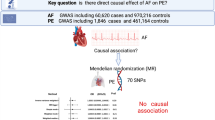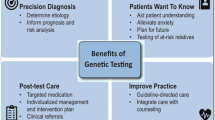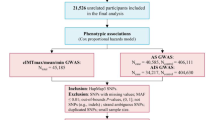Abstract
A recent genome-wide association study (GWAS) identified a nonsynonymous SNP (1425G/A) in PRKCH which was associated with increased risk of ischemic stroke. The purpose of this study was to examine whether this functional polymorphism is associated with stroke onset and prognosis in a Chinese population. We genotyped PRKCH 1425G/A using Improved Multiple Ligase Detection Reaction in 919 patients with ischemic stroke. Analyses of genotype association with onset and prognosis outcomes were assessed by the Kaplan-Meier method, the log-rank test, and the Cox proportional hazards models. PRKCH 1425G/A was not associated with age of stroke onset (P = 0.323). However, this functional polymorphism was significantly associated with risk of stroke recurrence in recessive models (hazard ratio [HR] = 2.23; 95 % confidential interval [CI], 1.06 to 4.68; P = 0.014), and this effect was more predominant among smokers (HR = 3.67; 95 % CI, 1.47–9.18; P = 0.005). Moreover, the variant genotypes of PRKCH 1425G/A are an independent prognostic factor for ischemic stroke in the final multivariate Cox regression model. Our findings show that PRKCH 1425G/A may be a useful biomarker for predicting the recurrence of ischemic stroke.



Similar content being viewed by others
Abbreviations
- HR:
-
Hazard ratio
- CI:
-
Confidence interval
- GWAS:
-
Genome-wide association study
References
Bonita R, Mendis S, Truelsen T, Bogousslavsky J, Toole J, Yatsu F (2004) The global stroke initiative. Lancet Neurol 3:391–393
Seshadri S, Beiser A, Pikula A et al (2010) Parental occurrence of stroke and risk of stroke in their children: the Framingham study. Circulation 121:1304–1312
Meschia JF, Worrall BB, Rich SS (2011) Genetic susceptibility to ischemic stroke. Nat Rev Neurol 7:369–378
Hirschhorn JN, Daly MJ (2005) Genome-wide association studies for common diseases and complex traits. Nat Rev Genet 6:95–108
Kubo M, Hata J, Ninomiya T et al (2007) A nonsynonymous SNP in PRKCH (protein kinase C eta) increases the risk of cerebral infarction. Nat Genet 39:212–217
Chen YC, Chen P, Wu YR et al (2012) Protein kinase Ceta polymorphism and the susceptibilities to intracerebral hemorrhage in the Taiwan population. Neurosci Lett 528:170–173
Serizawa M, Nabika T, Ochiai Y et al (2008) Association between PRKCH gene polymorphisms and subcortical silent brain infarction. Atherosclerosis 199:340–345
Wu L, Shen Y, Liu X et al (2009) The 1425G/A SNP in PRKCH is associated with ischemic stroke and cerebral hemorrhage in a Chinese population. Stroke 40:2973–2976
Liu X, Xu G, Wu W, Zhang R, Yin Q, Zhu W (2006) Subtypes and one-year survival of first-ever stroke in Chinese patients: the Nanjing stroke registry. Cerebrovasc Dis 22:130–136
Zhang Z, Xu G, Zhu W et al (2014) Chromosome 12p13 variants predict recurrence of ischaemic stroke in a Chinese population. Eur J Neurol. doi:10.1111/ene.12508
Thomas G, Sinville R, Sutton S et al (2004) Capillary and microelectrophoretic separations of ligase detection reaction products produced from low-abundant point mutations in genomic DNA. Electrophoresis 25:1668–1677
Nishizuka Y (1995) Protein kinase C and lipid signaling for sustained cellular responses. FASEB J 9:484–496
Goldstein LB, Adams R, Alberts MJ et al (2006) Primary prevention of ischemic stroke: a guideline from the American Heart Association/American Stroke Association Stroke Council: cosponsored by the Atherosclerotic Peripheral Vascular Disease Interdisciplinary Working Group; Cardiovascular Nursing Council; Clinical Cardiology Council; Nutrition, Physical Activity, and Metabolism Council; and the Quality of Care and Outcomes Research Interdisciplinary Working Group: the American Academy of Neurology affirms the value of this guideline. Stroke 37:1583–1633
Messner B, Bernhard D (2014) Smoking and cardiovascular disease: mechanisms of endothelial dysfunction and early atherogenesis. Arterioscler Thromb Vasc Biol 34:509–515
Wannamethee SG, Lowe GD, Shaper AG, Rumley A, Lennon L, Whincup PH (2005) Associations between cigarette smoking, pipe/cigar smoking, and smoking cessation, and haemostatic and inflammatory markers for cardiovascular disease. Eur Heart J 26:1765–1773
Barua RS, Ambrose JA, Saha DC, Eales-Reynolds LJ (2002) Smoking is associated with altered endothelial-derived fibrinolytic and antithrombotic factors: an in vitro demonstration. Circulation 106:905–908
Wilhelmsen L, Svardsudd K, Korsan-Bengtsen K, Larsson B, Welin L, Tibblin G (1984) Fibrinogen as a risk factor for stroke and myocardial infarction. N Engl J Med 311:501–505
Newby DE, Wright RA, Labinjoh C et al (1999) Endothelial dysfunction, impaired endogenous fibrinolysis, and cigarette smoking: a mechanism for arterial thrombosis and myocardial infarction. Circulation 99:1411–1415
Renaud S, Blache D, Dumont E, Thevenon C, Wissendanger T (1984) Platelet function after cigarette smoking in relation to nicotine and carbon monoxide. Clin Pharmacol Ther 36:389–395
Smith JR, Landaw SA (1978) Smokers’ polycythemia. N Engl J Med 298:6–10
Acknowledgments
This work was supported by National Natural Science Foundation of China (31200938, 81220108008); Natural Science Foundation of Jiangsu Province (BK2011021); and Natural Science Foundation of Jinling Hospital (2012009). The funders had no role in study design, data collection and analysis, decision to publish, or preparation of the manuscript. The authors thank Benjamin L. Kidder (Systems Biology Center, National Heart, Lung and Blood Institue, National Institutes of Health, Bethesda, MD 20892, USA) for critical review and language editing of the manuscript.
Conflict of Interests
The authors declare that they have no conflicts of interest.
Author information
Authors and Affiliations
Corresponding author
Electronic supplementary material
Below is the link to the electronic supplementary material.
ESM 1
(DOC 33 kb)
Rights and permissions
About this article
Cite this article
Zhang, Z., Xu, G., Zhu, W. et al. PRKCH 1425G/A Polymorphism Predicts Recurrence of Ischemic Stroke in a Chinese Population. Mol Neurobiol 52, 1648–1653 (2015). https://doi.org/10.1007/s12035-014-8964-6
Received:
Accepted:
Published:
Issue Date:
DOI: https://doi.org/10.1007/s12035-014-8964-6




